D3 and D4 HONDA ACCORD SEDAN 2000 (in English) Manual PDF
[x] Cancel search | Manufacturer: HONDA, Model Year: 2000, Model line: ACCORD SEDAN, Model: HONDA ACCORD SEDAN 2000Pages: 329, PDF Size: 4.66 MB
Page 170 of 329

Carryin
g Carg o
Loa d Limi t
Th e maximu m loa d fo r you r ca r i s
85 0 lbs(395 kg) .
Thi s figur e include s th e tota l weigh t
o f al l occupants , cargo , accessories ,
an d th e tongu e weigh t i f yo u ar e
towin g a trailer .
T o figur e ou t ho w muc h carg o yo u
ca n carry :
Ad d u p th e weigh t o f al l occupants .
I f yo u ar e towin g a trailer , ad d th e
tongu e weigh t t o th e numbe r
above .
Subtrac t th e tota l fro m 85 0 Ib s
(395 kg) .
Th e fina l numbe r i s th e tota l weigh t
o f carg o yo u ca n carry .
Carryin
g Item s i n th e Passenge r
Compartmen t
Stor e o r secur e al l item s tha t coul d
b e throw n aroun d an d hur t
someon e durin g a crash .
D o no t pu t an y item s o n to p o f th e
rea r shelf . The y ca n bloc k you r
vie w an d b e throw n aroun d th e ca r
durin g a crash .
B e sur e item s place d o n th e floo r
behin d th e fron t seat s canno t rol l
unde r th e seat s an d interfer e wit h
th e driver' s abilit y t o operat e th e
pedals , o r wit h th e prope r
operatio n o f th e seats .
Kee p th e glov e bo x close d whil e
driving . I f th e li d is open , a
passenge r coul d injur e thei r knee s
durin g a cras h o r sudden stop.
Befor e Drivin g
Overloadin
g o r imprope r
loadin g ca n affec t handlin g an d
stabilit y an d caus e a cras h in
whic h yo u ca n b e hur t o r killed .
Follo w al l loa d limit s an d othe r
loadin g guideline s in thi s
manual .
Page 180 of 329

Automati
c Transmissio n
Driv e (D 3) —Thi s positio n i s simila r
t o D 4, excep t onl y th e firs t thre e
gear s ar e selected . Us e D 3 whe n
towin g a traile r i n hill y terrain , o r t o
provid e engin e brakin g whe n goin g
dow n a stee p hill . D 3 ca n als o kee p
th e transmissio n fro m cyclin g
betwee n thir d an d fourt h gear s i n
stop-and-g o driving .
Fo r faste r acceleratio n whe n i n D 3 o r
D 4, yo u ca n ge t th e transmissio n to
automaticall y downshif t b y pushin g
th e accelerato r peda l t o th e floor .
Th e transmissio n wil l shif t dow n on e
o r tw o gears , dependin g o n you r
speed .
Secon
d (2 ) — To shif t t o Second ,
pres s th e releas e butto n o n th e sid e
o f th e shif t lever . Thi s positio n lock s
th e transmissio n in secon d gear . I t
doe s no t downshif t t o firs t gea r
whe n yo u com e to a stop . Secon d
give s yo u mor e powe r whe n climbing ,
an d increase d engin e brakin g whe n
goin g dow n stee p hills . Us e secon d
gea r whe n startin g ou t o n a slipper y
surfac e o r i n dee p snow . I t wil l hel p
reduc e wheelspin . Firs
t (1 ) — To shif t fro m Secon d t o
First , pres s th e releas e butto n o n th e
sid e o f th e shif t lever . Wit h th e leve r
i n thi s position , th e transmissio n
lock s i n Firs t gear . B y upshiftin g an d
downshiftin g throug h 1 , 2 , D 3 an d D 4,
yo u ca n operat e thi s transmissio n
muc h lik e a manua l transmissio n
withou t a clutc h pedal .
Drivin g
Page 183 of 329

Parkin
g
Alway s us e th e parkin g brak e whe n
yo u par k you r car . Th e indicato r o n
th e instrumen t pane l show s tha t th e
parkin g brak e is no t full y released ; i t
doe s no t indicat e tha t th e parkin g
brak e is firml y set . Mak e sur e th e
parkin g brak e is se t firml y o r you r
ca r ma y rol l i f i t i s parke d o n a n
incline .
I f you r ca r ha s a n automati c
transmission , se t th e parkin g brak e
befor e yo u pu t th e transmissio n in
Park . Thi s keep s th e ca r fro m
movin g an d puttin g pressur e o n th e
parkin g mechanis m in th e
transmissio n — makin g it easie r t o
mov e th e shif t leve r ou t o f Par k
whe n yo u wan t t o driv e away . I
f th e ca r i s facin g uphill , tur n th e
fron t wheel s awa y fro m th e curb . I f
yo u hav e a manua l transmission , pu t
i t i n firs t gear .
I f th e ca r i s facin g downhill , tur n th e
fron t wheel s towar d th e curb . I f yo u
hav e a manua l transmission , pu t i t i n
revers e gear .
Mak e sur e th e parkin g brake is full y
release d befor e drivin g away .
Drivin g wit h th e parkin g brak e
partiall y se t ca n overhea t o r damag e
th e rea r brakes . Parkin
g Tip s
Mak e sur e th e moonroo f an d th e
window s ar e closed .
Tur n of f th e lights .
Plac e an y packages , valuables , etc. ,
i n th e trun k o r tak e the m wit h you .
Loc k th e door s wit h th e ke y o r th e
remot e transmitter .
On SE, EX and EX-V6 models
Chec k th e indicato r o n th e driver' s
doo r t o verif y tha t th e securit y
syste m is set .
Neve r par k ove r dr y leaves , tal l
grass , o r othe r flammabl e
materials . Th e thre e wa y catalyti c
converte r get s ver y hot , an d coul d
caus e thes e material s t o catc h o n
fire .
Drivin g
Page 184 of 329

Th
e Brakin g Syste m
You r Hond a is equippe d wit h fron t
dis c brakes . Th e brake s o n th e rea r
wheel s ma y b e dis c o r drum ,
dependin g o n model . A powe r assis t
help s reduc e th e effor t neede d o n
th e brak e pedal .
Pu t you r foo t o n th e brak e peda l onl y
whe n yo u inten d t o brake . Restin g
you r foo t o n th e peda l keep s th e
brake s applie d lightly , causin g the m
t o buil d u p heat . Hea t build-u p ca n
reduc e ho w wel l you r brake s work . I t
als o keep s you r brak e light s o n al l
th e time , confusin g driver s behin d
you .
Constan
t applicatio n o f th e brake s
whe n goin g dow n a lon g hil l build s
u p hea t an d reduce s thei r effective -
ness . Us e th e engin e to assis t th e
brake s b y downshiftin g to a lowe r
gea r an d takin g you r foo t of f th e
accelerato r pedal .
Chec k you r brake s afte r drivin g
throug h dee p water . Appl y th e
brake s moderatel y t o se e if the y fee l
normal . I f not , appl y the m gentl y an d
frequentl y unti l the y do . Sinc e a
longe r distanc e is neede d to sto p
wit h we t brakes , b e extr a cautiou s
an d aler t i n you r driving . Brak
e Wea r Indicator s
Th e fron t dis c brake s o n al l model s
hav e audibl e brak e wea r indicators .
The y ar e als o o n th e rea r brake s o f
car s equippe d wit h AB S a s standar d
equipment .
Whe n th e brak e pad s nee d replacing ,
yo u wil l hea r a distinctiv e metalli c
"screeching " soun d whe n yo u appl y
th e brakes . I f yo u d o no t hav e th e
brak e pad s replaced , the y wil l begi n
screechin g al l th e time .
You r brake s ma y sometime s squea l
o r squea k whe n yo u appl y the m
lightly . D o no t confus e thi s wit h th e
brak e wea r indicators . The y mak e a
ver y audibl e "screeching. "
Drivin g
Page 185 of 329
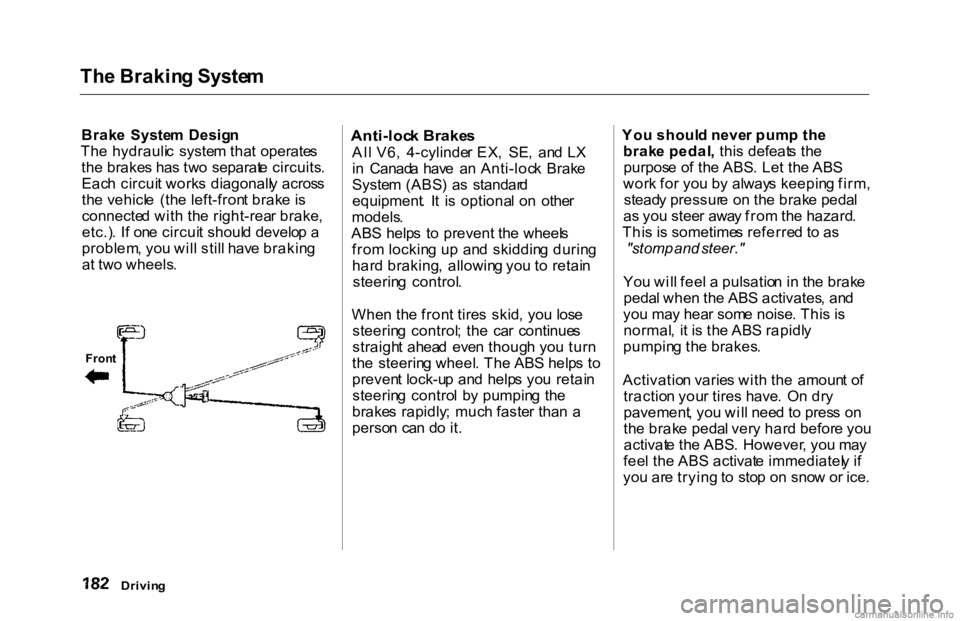
Th
e Brakin g Syste m
Brak e Syste m Desig n
Th e hydrauli c syste m tha t operate s
th e brake s ha s tw o separat e circuits .
Eac h circui t work s diagonall y acros s
th e vehicl e (th e left-fron t brak e is
connecte d wit h th e right-rea r brake ,
etc.) . I f on e circui t shoul d develo p a
problem , yo u wil l stil l hav e brakin g
a t tw o wheels .
Anti-loc
k Brake s
Al l V6 , 4-cylinde r EX , SE , an d L X
i n Canad a hav e a n Anti-loc k Brak e
Syste m (ABS ) a s standar d
equipment . I t i s optiona l o n othe r
models .
AB S help s t o prevent the wheel s
fro m lockin g u p an d skiddin g durin g
har d braking , allowin g yo u t o retai n
steerin g control .
Whe n th e fron t tire s skid , yo u los e
steerin g control ; th e ca r continue s
straigh t ahea d eve n thoug h yo u tur n
th e steerin g wheel . Th e AB S help s t o
preven t lock-u p an d help s yo u retai n
steerin g contro l b y pumpin g th e
brake s rapidly ; muc h faste r tha n a
perso n ca n d o it . Yo
u shoul d neve r pum p th e
brak e pedal , thi s defeat s th e
purpos e o f th e ABS . Le t th e AB S
wor k fo r yo u b y alway s keepin g firm ,
stead y pressur e o n th e brak e peda l
a s yo u stee r awa y fro m th e hazard .
Thi s i s sometime s referre d t o a s
"stomp and steer."
Yo u wil l fee l a pulsatio n in th e brak e
peda l whe n th e AB S activates , an d
yo u ma y hea r som e noise . Thi s i s
normal , i t i s th e AB S rapidl y
pumpin g th e brakes .
Activatio n varie s wit h th e amoun t o f
tractio n you r tire s have . O n dr y
pavement , yo u wil l nee d t o pres s o n
th e brak e peda l ver y har d befor e yo u
activat e th e ABS . However , yo u ma y
fee l th e AB S activat e immediatel y i f
yo u ar e tryin g to sto p o n sno w o r ice .
Drivin g
Fron
t
Page 188 of 329
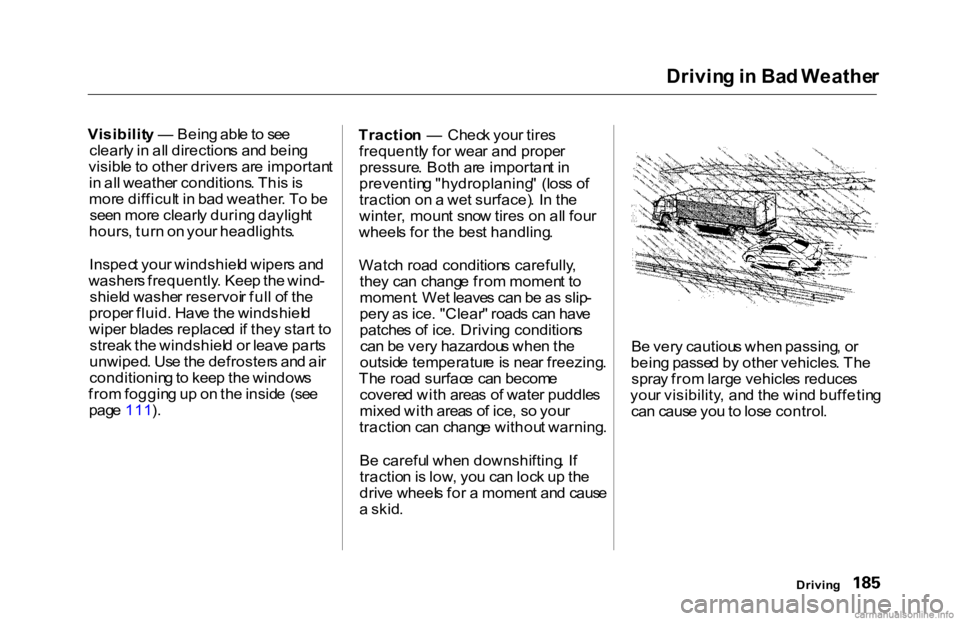
Drivin
g in Ba d Weathe r
Visibilit y — Bein g abl e to se e
clearl y in al l direction s an d bein g
visibl e to othe r driver s ar e importan t
i n al l weathe r conditions . Thi s is
mor e difficul t i n ba d weather . T o b e
see n mor e clearl y durin g dayligh t
hours , tur n o n you r headlights .
Inspec t you r windshiel d wiper s an d
washer s frequently . Kee p th e wind -
shiel d washe r reservoi r ful l o f th e
prope r fluid . Hav e th e windshiel d
wipe r blade s replace d if the y star t t o
strea k th e windshiel d o r leav e part s
unwiped . Us e th e defroster s an d ai r
conditionin g to kee p th e window s
fro m foggin g u p o n th e insid e (se e
pag e 111 ). Tractio
n — Chec k you r tire s
frequentl y fo r wea r an d prope r
pressure . Bot h ar e importan t i n
preventin g "hydroplaning " (los s o f
tractio n o n a we t surface) . I n th e
winter , moun t sno w tire s o n al l fou r
wheel s fo r th e bes t handling .
Watc h roa d condition s carefully ,
the y ca n chang e fro m momen t t o
moment . We t leave s ca n b e a s slip -
per y a s ice . "Clear " road s ca n hav e
patche s o f ice . Drivin g condition s
ca n b e ver y hazardou s whe n th e
outsid e temperatur e is nea r freezing .
Th e roa d surfac e ca n becom e
covere d wit h area s o f wate r puddle s
mixe d wit h area s o f ice , s o you r
tractio n ca n chang e withou t warning .
B e carefu l whe n downshifting . I f
tractio n is low , yo u ca n loc k u p th e
driv e wheel s fo r a momen t an d caus e
a skid . B
e ver y cautiou s whe n passing , o r
bein g passe d b y othe r vehicles . Th e
spra y fro m larg e vehicle s reduce s
you r visibility , an d th e win d buffetin g
ca n caus e yo u to los e control .
Drivin g
Page 189 of 329
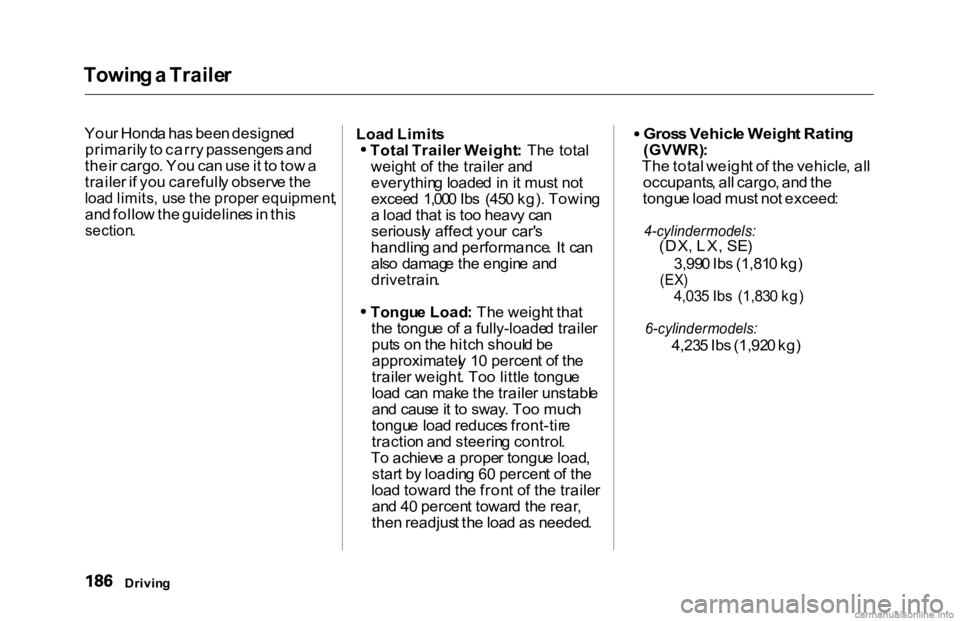
Towin
g a Traile r
You r Hond a ha s bee n designe d
primaril y to carr y passenger s an d
thei r cargo . Yo u ca n us e it t o to w a
traile r i f yo u carefull y observ e th e
loa d limits , us e th e prope r equipment ,
an d follo w th e guideline s in thi s
section .
Loa
d Limit s
Tota l Traile r Weight : Th e tota l
weigh t o f th e traile r an d
everythin g loade d in it mus t no t
excee d 1,00 0 Ib s (45 0 kg) . Towin g
a loa d tha t i s to o heav y ca n
seriousl y affec t you r car' s
handlin g an d performance . I t ca n
als o damag e th e engin e an d
drivetrain .
Tongu e Load : Th e weigh t tha t
th e tongu e o f a fully-loade d traile r
put s o n th e hitc h shoul d b e
approximatel y 1 0 percen t o f th e
traile r weight . To o littl e tongu e
loa d ca n mak e th e traile r unstabl e
an d caus e it t o sway . To o muc h
tongu e loa d reduce s front-tir e
tractio n an d steerin g control .
T o achiev e a prope r tongu e load ,
star t b y loadin g 6 0 percen t o f th e
loa d towar d th e fron t o f th e traile r
an d 4 0 percen t towar d th e rear ,
the n readjus t th e loa d a s needed .
Gros
s Vehicl e Weigh t Ratin g
(GVWR) :
Th e tota l weigh t o f th e vehicle , al l
occupants , al l cargo , an d th e
tongu e loa d mus t no t exceed :
4-cylinder models:
(DX , LX , SE )
3,99 0 Ib s (1,81 0 kg )
(EX )
4,03 5 Ib s (1,83 0 kg )
6-cylinder models:
4,23 5 Ib s (1,92 0 kg )
Drivin g
Page 190 of 329
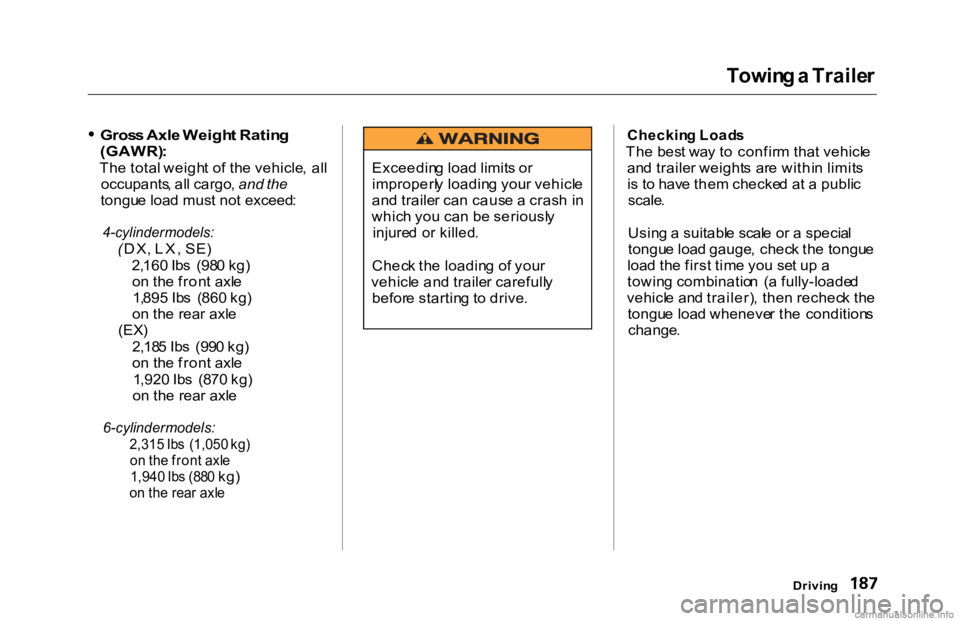
Towin
g a Traile r
Gros s Axl e Weigh t Ratin g
(GAWR) :
Th e tota l weigh t o f th e vehicle , al l
occupants , al l cargo , and the
tongu e loa d mus t no t exceed :
4-cylinder models:
( DX , LX , SE )
2, 160 Ibs (98 0 kg )
o n th e fron t axl e
1, 895 Ibs ( 860 kg)
o n th e rea r axl e
(EX )
2,18 5 Ib s (99 0 kg )
o n th e fron t axl e
1 ,920 Ibs (8 70 kg )
o n th e rea r axl e
6-cylinder models:
2,315 Ib s ( 1,050 kg)
o n th e fron t axl e
1,940 Ibs (88 0
kg )
o n th e rea r axl e
Checkin
g Load s
Th e bes t wa y t o confir m tha t vehicl e
an d traile r weight s ar e withi n limit s
i s t o hav e the m checke d a t a publi c
scale .
Usin g a suitabl e scal e o r a specia l
tongu e loa d gauge , chec k th e tongu e
loa d th e firs t tim e yo u se t u p a
towin g combinatio n ( a fully-loade d
vehicl e an d trailer) , the n rechec k th e
tongu e loa d wheneve r th e condition s
change .
Driving
Exceedin
g loa d limit s o r
improperl y loadin g you r vehicl e
an d traile r ca n caus e a cras h i n
whic h yo u ca n b e seriousl y
injure d o r killed .
Chec k th e loadin g o f you r
vehicl e an d traile r carefull y
befor e startin g t o drive .
Page 192 of 329
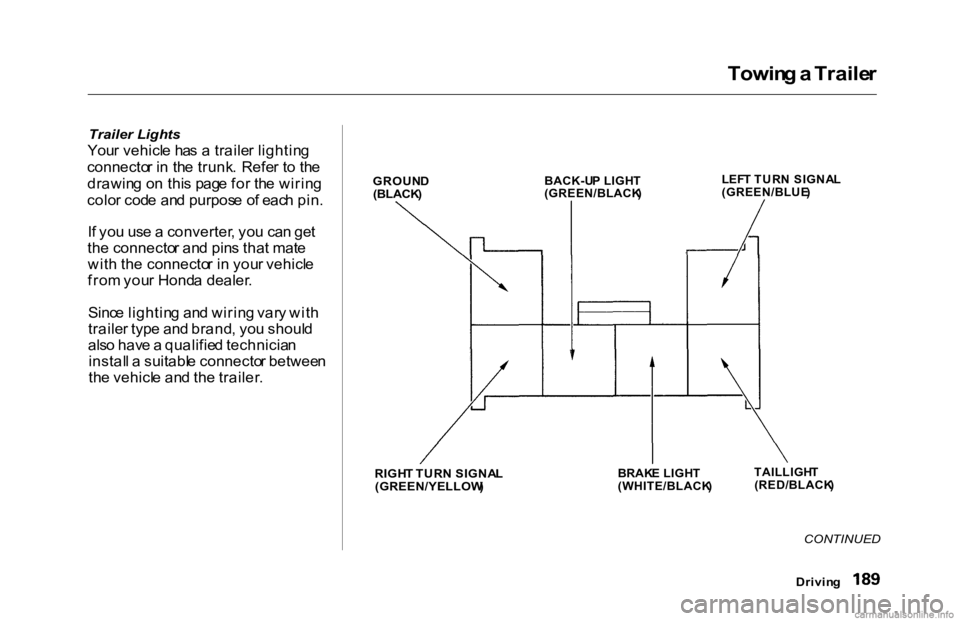
Towin
g a Traile r
Trailer Lights
You r vehicl e ha s a traile r lightin g
connecto r i n th e trunk . Refe r t o th e
drawin g o n thi s pag e fo r th e wirin g
colo r cod e an d purpos e o f eac h pin .
I f yo u us e a converter , yo u ca n ge t
th e connecto r an d pin s tha t mat e
wit h th e connecto r i n you r vehicl e
fro m you r Hond a dealer .
Sinc e lightin g an d wirin g var y wit h
traile r typ e an d brand , yo u shoul d
als o hav e a qualifie d technicia n
instal l a suitabl e connecto r betwee n
th e vehicl e an d th e trailer .
Driving
CONTINUED
GROUN
D
(BLACK )
BACK-U
P LIGH T
(GREEN/BLACK )LEF
T TUR N SIGNA L
(GREEN/BLUE )
RIGH T TUR N SIGNA L
(GREEN/YELLOW )
BRAK
E LIGH T
(WHITE/BLACK )TAILLIGH
T
(RED/BLACK )
Page 194 of 329

Towin
g a Traile r
Drivin g Safel y Wit h a Traile r
Th e adde d weight , length , an d
heigh t o f a traile r wil l affec t you r
vehicle' s handlin g an d performance ,
s o drivin g wit h a traile r require s
som e specia l drivin g skill s an d
techniques .
Fo r you r safet y an d th e safet y o f
others , tak e tim e t o practic e drivin g
maneuver s befor e headin g fo r th e
ope n road , an d follo w th e guideline s
discusse d below .
Towing Speeds and Gears
Driv e slowe r tha n norma l i n al l
drivin g situations , an d obe y poste d
spee d limit s fo r vehicle s wit h trailers .
I f yo u hav e a n automati c transmission ,
use the D 4 position when towing a
traile r o n leve l roads . D 3 i s th e prope r
shif t leve r positio n to us e whe n towin g
a traile r i n hill y terrain . (Se e "Driving
o n Hills " in th e nex t colum n fo r
additiona l gea r
information.
)
Making
Turns and Braking
Mak e turn s mor e slowl y an d wide r
tha n normal . Th e traile r track s a
smalle r ar c tha n you r vehicle , an d it
ca n hi t o r ru n ove r somethin g th e
vehicl e misses . Allo w mor e tim e an d
distanc e fo r braking . D o no t brak e o r
tur n suddenl y a s thi s coul d caus e th e
traile r t o jackknif e o r tur n over .
Driving on Hills
Whe n climbin g hills , closel y watc h
you r temperatur e gauge . I f i t near s
th e re d (Hot ) mark , tur n th e ai r
conditionin g off , reduc e spee d and ,
i f necessary , pul l t o th e sid e o f th e
roa d t o le t th e engin e cool .
I f th e automati c transmissio n shift s
frequentl y betwee n 3r d an d 4t h
gear s whil e goin g u p a hill , shif t t o
D 3.
I
f yo u mus t sto p whe n facin g uphill ,
us e th e foo t brak e o r parkin g brake .
D o no t tr y t o hol d th e vehicl e in
plac e b y pressin g o n th e accelerator ,
a s thi s ca n caus e th e transmissio n to
overheat .
Whe n drivin g dow n hills , reduc e
you r spee d an d shif t dow n to 2n d
gear . D o no t "ride " th e brakes , an d
remembe r i t wil l tak e longe r t o slo w
dow n an d sto p whe n towin g a trailer .
Drivin g
CONTINUED